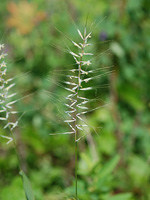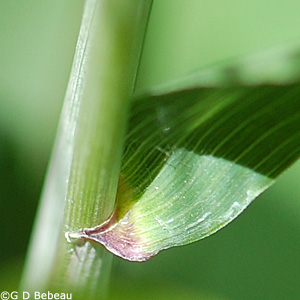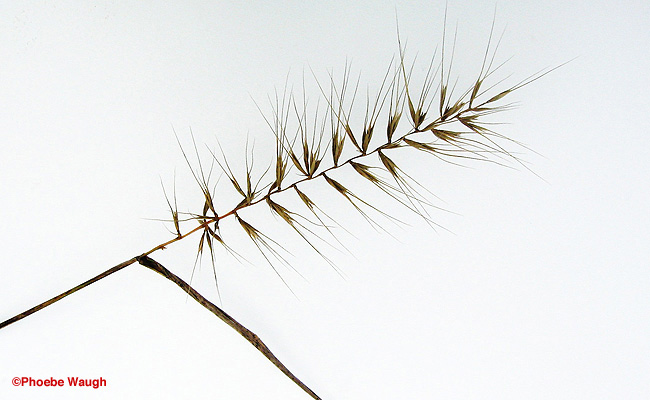The Friends of the Wildflower Garden, Inc.
Grasses of the Eloise Butler Wildflower Garden
The oldest public wildflower garden in the United States

Common Name
Eastern Bottlebrush Grass
Scientific Name
Elymus hystrix L.
Plant Family
Poaceae (Grasses)
Garden Location
Upland & Woodland
Prime Season
June to August
Grass structure and definitions - PDF from Oregon State University
Eastern Bottlebrush Grass is identified by the characteristic seed head. The stem, up to 5 feet long, is normally very upright and can persist into the fall. This is a warm season grass, flowering in summer.
Leaves: The leaf blades are blue-gray, 1/2 inch wide (8-15 mm), are evenly distributed and are held horizontally from the stalk but the lower leaves can flop. The area of the leaf auricle and ligule is usually brown to brownish-black. Ligules are short - 1 to 2 mm. Auricles are 0.5 to 3 mm. Sheaths are usually smooth and often purplish.
The inflorescence is raceme-like, 2 to 4 inches wide and 6 to 8 inches long, with a central rachis slightly angled at the nodes. The rachis has two spikelets attached to each node. The spikelets will spread widely apart at maturity.
Spikelets: Spikelets are are 10 to 18 mm long long and held almost horizontally when mature, usually 2 per node, rarely 3. These diverge strongly when mature, each containing 2 to 4 florets but only the lowest are functional. There are 3 anthers. Glumes are very narrow and awn-like or lacking entirely. The lemmas are straight, 8 to 11 mm long, with or without hair depending on the variety, and gradually tapering to a rough, straight, rarely curving, awn that is 10 to 40 mm long.
Seed: The seeds have a bristle tip (awns), thus making the raceme, with the spikelets spreading horizontally, resemble a bottle brush.
Varieties: There are two defined varieties. The variety in the Garden, E. hystrix var. hystrix has hairless lemmas (there is a chafe-like scale or husk, on the lowest bracts of a grass spikelet called a "glume" and the lemma is a small chaffy bract inside and above the glume). The other variety, var. bigelovianus, has hairy lemmas. E. hystrix hybridizes with many eastern species of Elymus and hybrids may be found. Although both varieties were once catalogued as present in Minnesota, and USDA still illustrates the county occurances, the Minnesota DNR plant census and the University of Minnesota Vascular Plant census no longer separate the varieties.
Habitat: Bottlebrush is very shade tolerant grass and also drought tolerant. It will grow in dry to moist soils of good quality. While full sun is acceptable, the plant does well in the light shade of a wooded understory. The plant will self-seed and in the fall the foliage can take on a chartreuse color. As the seed readily scatters and self seeds, care should be taken where it is planted in a home landscape.
Names: An older scientific name for this plant is Hystrix patula. The genus Elymus is taken from the Greek elyo, meaning 'rolled-up', being a name for a type of grain where the lemma and palea are tightly rolled around the seed. The species, hystrix (and the older genus name for the plant) means bristly. The author name for the plant classification - 'L.' refers to Carl Linnaeus (1707-1778), Swedish botanist and the developer of the binomial nomenclature of modern taxonomy.
Comparisons: Other species of Elymus found in the Garden are Quackgrass, Elymus repens and Wild Rye & Canada Wild Rye, Elymus sp. & E. Canadensis.


Above: The erect stem and flower head of Eastern Bottlebrush. While Bottlebrush is quite shade tolerant it does better in full sun.
Below: The small ligule and auricle of the leaf. This area can be brown to brownish-black in color. The leaf sheath can have a purplish color.


Below: Stem nodes are swollen, whitish, and can have a purplish coloration beneath. In the 2nd photo the inflorescence is emerging from the stem.


Below: 1st photo - There are usually 2 spiklets at each node. These begin to diverge and spread horizontally as soon as the inflorescence is free of the sheath. 2nd photo - Upper leaves are held ascending to horizontally from the stem.


Below: The seed panicle at flowering time - divergence of the two spikelets at each node of the rachis already developed.

Below: Details of the seed head of Eastern Bottlebrush. Note the divergence of the two spikelets at each node of the rachis. Several have already fallen away in this photo. Photo ©Phoebe Waugh

Notes: Eastern Bottlebrush is indigenous to the Garden. Eloise Butler catalogued it on Sept. 6, 1907 using the older name of Hystrix patula. Additional plantings were made by Gardener Cary George in 1987 and by Susan Wilkins in 2009.
Eastern Bottlebrush is found in the states and lower Canadian Provinces east of the Great Plains and as far south as Oklahoma. In Minnesota E. hystrix is found in most of the state.
Eastern Bottlebrush is one of nine species of Elymus found in Minnesota. The others are mostly all native species of rhy grass. The lone exception is the non-native Quackgrass.
Return to -- Site Plan/Archive Index --or-- List of Common Plant Names -- or -- List of Scientific Names -- or --Home Page - - - Back to top.
References: Plant characteristics are generally from sources 1A, 32, W2, W3, W7 & W8 plus others as specifically applied. Distribution principally from W1, W2 and 28C. Planting history generally from 1, 4 & 4a. Other sources by specific reference. See Reference List for details.
 Identification booklet for most of the flowering forbs and small flowering shrubs of the Eloise Butler Wildflower Garden. Details Here.
Identification booklet for most of the flowering forbs and small flowering shrubs of the Eloise Butler Wildflower Garden. Details Here.
©2015
Friends of the Wildflower Garden, Inc. Text and photos are by G. D. Bebeau unless otherwise credited. "www.friendsofeloisebutler.org"
071422